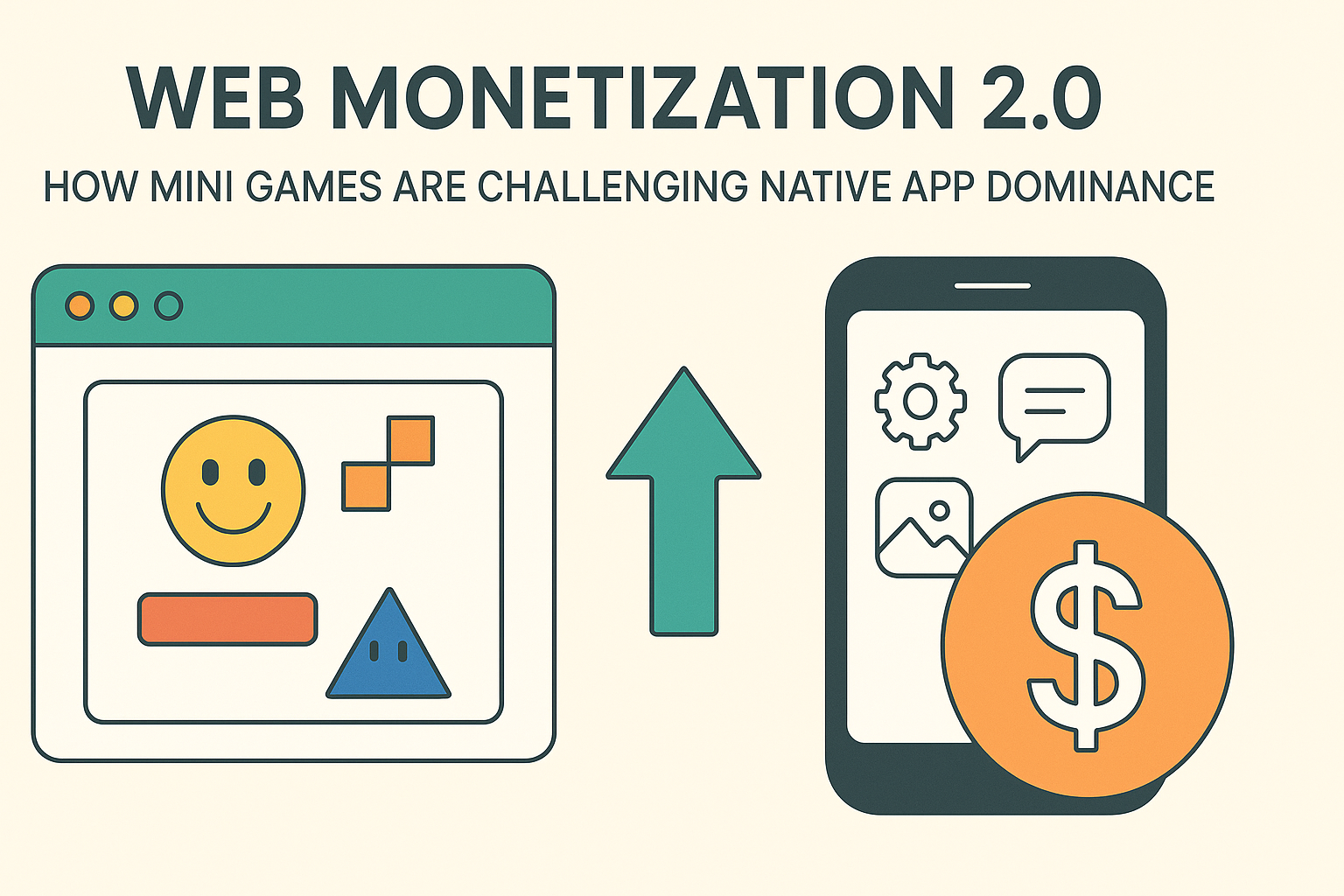Web Monetization 2.0: How Mini Games Are Challenging Native App Dominance
Starting on ‘Web Monetization 2.0: How Mini Games Are Challenging Native App Dominance’ post, native apps have ruled the mobile landscape for over a decade. Their ecosystem of app stores and in-app purchases has defined the standard for mobile gaming and monetization. But 2025 marks a turning point. Mini Games—lightweight, browser-based experiences—are emerging as powerful challengers to this established order.
This shift represents Web Monetization 2.0. It’s transforming how developers create, distribute, and profit from digital experiences.
Contents
- 1 The Eastern Success Story
- 2 What Held the West Back
- 3 The 2025 Browser Gaming Revolution
- 4 Mini Games vs. Native Apps: The Comparison
- 5 Effective Web Monetization Strategies
- 6 Technical Advancements Enabling Mini Games
- 7 Case Studies: Mini Game Success Stories
- 8 The Developer Advantage
- 9 Challenges and Limitations
- 10 AppLixir Monetization
The Eastern Success Story
China’s WeChat Mini Games created a $5.4 billion industry with 500+ million monthly users. These games require no downloads and operate seamlessly within WeChat’s ecosystem. Players enjoy instant access, integrated social features, and frictionless payments through microtransactions and rewarded ads.
Similar ecosystems thrived in other Asian markets. Kakao’s mini-app platform in South Korea reached 45 million users within its ecosystem. LINE Mini Games in Japan and Taiwan attracted 32 million monthly players across its messaging platform. Paytm’s Mini Games in India grew to 28 million users in just 18 months, demonstrating rapid adoption in emerging markets.
Western platforms struggled to replicate this success due to app store restrictions.
What Held the West Back
Apple’s App Store policies created significant barriers. The rules prohibited alternative payment systems within applications. They restricted in-app game marketplaces that could compete with the App Store. The policies limited fully-featured HTML5 games to prevent bypass of store guidelines. Commission-free monetization was effectively blocked, maintaining Apple’s revenue share requirements.
Google Play imposed similar limitations, though less stringently. These restrictions prevented Facebook, Telegram, and other platforms from building vibrant mini-game ecosystems.
Research from Newzoo shows that 78% of Western developers cited platform restrictions as the primary obstacle to browser-based game development.
The 2025 Browser Gaming Revolution
Continuing on ‘Web Monetization 2.0: How Mini Games Are Challenging Native App Dominance’ post,, three key developments are driving the current mini-game revolution:
1. Regulatory Pressure on App Stores
Global regulators have forced significant changes to Apple’s policies. The Digital Markets Act in Europe, antitrust rulings in the US, and similar legislation worldwide have created new opportunities. Alternative payment methods are now permitted across major platforms. Browser engines face fewer restrictions, enabling more powerful web applications. Web-based applications can access more device features previously limited to native apps. Notification systems for web apps have improved, closing a key engagement gap with native applications.
The Epic v. Apple case aftermath opened crucial doors for browser-based monetization strategies.
2. Platform Investment in Gaming
Major platforms have renewed their focus on in-app gaming. Meta has launched “Horizon Games,” an evolution of its Facebook Instant Games with enhanced social features. Telegram’s Mini Apps platform now hosts over 1,000 games with integrated payments and messaging capabilities. Discord’s Activity platform supports complex multiplayer experiences directly within server channels. Spotify has introduced interactive gaming elements for music promotion, connecting artists with fans through playable experiences.
Each platform brings unique advantages—Meta’s vast user base, Telegram’s payment infrastructure, Discord’s community features, and Spotify’s audio integration.
3. Advanced Web Monetization Tools
New monetization tools have emerged specifically for web-based games. AppLixir and IronSource have developed web-specific SDKs for rewarded video that match native app performance. Xsolla and Stripe offer specialized payment solutions for browser games with optimized conversion flows. PlayFab extended its backend services to HTML5 and WebGL games, providing comprehensive analytics and player management. Unity’s Web Monetization package simplifies revenue generation across multiple channels and formats.
These tools deliver monetization capabilities previously available only to native apps.
Mini Games vs. Native Apps: The Comparison
| Feature | Mini Games | Native Apps |
|---|---|---|
| Distribution | Instant play via links or platforms | Requires app store download |
| Monetization | AppLixir Rewarded ads, offerwalls, direct payments | IAPs, subscriptions, ads |
| User Acquisition | Lower costs, viral potential | Higher CAC, CPI campaigns |
| Development Speed | Rapid iteration, instant updates | Slower with review processes |
| Performance | Improving but still limited | Full hardware access |
| Cross-Platform | One codebase for all devices | Platform-specific development |
| Analytics | Emerging but less robust | Mature tracking solutions |
| User Retention | Generally lower, easier abandonment | Higher investment from users |
Benchmark data from GameAnalytics shows mini games achieving 45-60% of the ARPDAU (Average Revenue Per Daily Active User) of native apps, but with development costs at just 30-40%.
Effective Web Monetization Strategies
Continuing on ‘Web Monetization 2.0: How Mini Games Are Challenging Native App Dominance’ post, developers are finding success with these monetization approaches:
1. Rewarded Video Advertising
Players opt-in to watch video ads in exchange for in-game benefits. This format achieves 3-5x higher eCPMs than banner ads in web environments.
Implementation requires strategic planning for maximum effectiveness. Developers should place ads at natural progression points where players are most receptive. Offering meaningful rewards that impact gameplay increases completion rates and player satisfaction. Limiting frequency prevents ad fatigue and maintains the gaming experience. Using adaptive ad timing based on player behavior optimizes both revenue and retention metrics.
2. Direct Web Payments
Browser-based purchases now bypass app store commissions. Services like Stripe, PayPal, and crypto payment gateways enable seamless transactions.
Successful approaches span multiple product categories across the gaming landscape. Cosmetic items and avatars appeal to players’ desire for personalization without affecting gameplay balance. Gameplay enhancements and power-ups provide tangible benefits that accelerate progress or enjoyment. Season passes and battle passes create ongoing engagement through progressive rewards. Limited-time offers and events drive urgency and capitalize on FOMO (fear of missing out) psychology.
3. Hybrid Monetization Models
The most successful mini games combine multiple revenue streams for maximum profitability. Core gameplay supported by ads ensures all players contribute to revenue regardless of spending habits. Premium content available via direct purchase appeals to players willing to pay for enhanced experiences. Subscription options for dedicated players create predictable revenue and higher lifetime value. Branded partnerships and sponsorships open additional revenue channels without disrupting the player experience.
Data from mobile analytics firm Sensor Tower indicates hybrid models increase LTV by 30-40% compared to single-revenue models.
Technical Advancements Enabling Mini Games
Browser capabilities have advanced significantly in recent years. WebGL 2.0 supports advanced 3D graphics comparable to early console generations. WebAssembly enables near-native performance for computation-heavy games and simulations. Progressive Web Apps provide offline capabilities essential for mobile gaming on unreliable connections. Web Audio API delivers complex sound experiences with spatial audio and effects processing. WebXR opens possibilities for immersive experiences in virtual and augmented reality directly in browsers.
These technologies narrow the gap between browser and native performance.
Case Studies: Mini Game Success Stories
Evony: The King’s Return (Web Version)
Top Seed’s browser version of their hit strategy game achieved:
- 35% lower user acquisition costs
- 22% higher virality through link sharing
- 15% of native app revenue within 6 months
- Successful cross-platform progression
Wordle and Daily Puzzle Games
The New York Times’ suite of browser games demonstrates:
- 28 million monthly players
- Ad revenue exceeding subscription conversion value
- 65% lower development costs than native alternatives
- Strong daily retention through habit formation
Playco’s Instant Games
This developer specializing in instant games reported:
- 80 million monthly players across platforms
- Development cycles 60% shorter than native apps
- CAC reduced by 40% compared to app store distribution
- Stronger performance on messaging platforms than social media
The Developer Advantage
Continuing on ‘Web Monetization 2.0: How Mini Games Are Challenging Native App Dominance’ post,, for game developers, Mini Games offer a set of advantages that are difficult to match with native app development. One of the most significant benefits is the ability to push instant updates. Unlike native apps, which often require lengthy approval cycles from app stores, web-based games can be updated in real time. This agility allows teams to fix bugs, balance gameplay, and roll out new content without delay, keeping the experience fresh and responsive to player feedback.
Another major win is the use of a single codebase. Developers can create one version of their game that works seamlessly across mobile, desktop, and tablet browsers. This dramatically reduces both development complexity and maintenance overhead. Rather than juggling separate builds for iOS, Android, and desktop, studios can focus their resources on improving gameplay and monetization.
Mini Games also give developers direct access to their communities. Without the layers of control imposed by app stores or third-party platforms, developers can build closer relationships with their players. This makes it easier to test new features, gather feedback, and grow loyal audiences through email lists, Discord servers, and social integrations. Community-building becomes a core part of the product strategy rather than an afterthought.
Challenges and Limitations
While Mini Games present a promising alternative to native apps, they are not without their challenges. One of the most prominent limitations is the reduced access to device-level features and hardware capabilities. Unlike native applications, which can integrate tightly with GPS, camera APIs, haptic feedback, and local storage, Mini Games running in browsers operate within more constrained environments. This can limit the types of experiences developers can create, particularly for genres that require intensive device interaction or high-end graphical performance.
Offline functionality also remains a hurdle. Although Progressive Web Apps (PWAs) offer some offline support, most Mini Games still depend on constant internet connectivity. This can be a drawback in regions with unstable connections or for players who expect to play on the go without relying on data. Until web standards and browser support for offline caching improve further, this limitation will continue to influence player expectations and behavior.
Another issue lies in perception. Many consumers still view browser-based games as less polished or lower in quality than their native counterparts. This stigma can impact player retention and monetization, even if the game itself is well-designed. Bridging this perception gap will require continued innovation from developers and thoughtful presentation from platforms to show that browser games can deliver premium experiences.
The monetization ecosystem for web games, though growing, still lacks the maturity and sophistication found in native app markets. While platforms like AppLixir, Xsolla, and IronSource are pushing the boundaries, some developers find the current ad mediation, analytics, and payment tools less robust compared to what’s available in ecosystems like AdMob or Unity Ads for mobile. This makes it harder to optimize revenue and scale monetization efforts across large audiences.
AppLixir Monetization
Last but not least, ‘Web Monetization 2.0: How Mini Games Are Challenging Native App Dominance’ post, Web Monetization 2.0 is more than just a shift in technology—it’s a redefinition of how games are built, shared, and monetized. At the heart of this transformation lies a simple but powerful idea: games don’t need to be trapped behind app store walls. They can live in the browser—frictionless, instant, and just as profitable. That’s exactly where AppLixir comes in.
Mini Games thrive on speed, reach, and accessibility. But monetization is what makes them sustainable. AppLixir provides the infrastructure that turns great HTML5 and WebGL games into revenue-generating products. With our rewarded video ad platform, developers can integrate high-performance, user-friendly ad units that fit naturally into gameplay—without sacrificing the user experience. Players get value through in-game rewards. Developers get value through high eCPMs, reliable fill rates, and global demand from top-tier advertisers.
This isn’t just an ad solution. It’s a monetization engine built specifically for the realities of the web. While most ad networks focus on native apps, AppLixir was built from the ground up for browser-based games, where traditional SDKs fall short and latency kills engagement. Our lightweight, easy-to-integrate SDK ensures that your game runs smoothly on any device, from low-end Android browsers to high-end desktop rigs.



